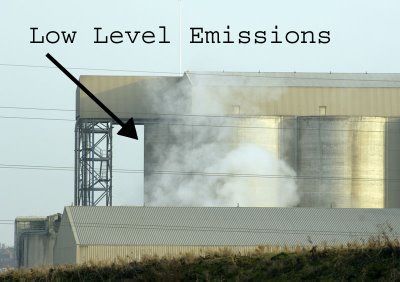
The focus on the significance of the stack emissions has now moved away onto the previously hidden air quality and health impact of the Low level Sources. Rugby people require a TOTAL BURDEN figure for this plant, which has been increasing pollution year on year as production increases, and waste burning increases, and as raw materials are replaced by other wastes. The old plant was very polluting and dirty, but they closed down six dirty old kilns and built this new semi-wet process plant, (in order to replace them all), in the most ENVIRONMENTALLY DETRIMENTAL SITE of all – in the middle of a town, surrounded by vulnerable receptors in an already deprived area, with no available raw materials, no transport, no rail connections, no road connections, and no possible justification – except it was cheaper for Rugby Cement as the other real estate was worth more to them. The Environment Agency and Rugby Borough Council claim to have been party to this and helped in the design and development of this plant all along the line.
“Experts” now chew over last year’s tyre trial results as the Agency and Rugby Cemex Cement try to prove that Rugby town centre really is the Best Practicable Environmental Option for the disposal/co-incineration of waste – tyres for starters – and soon to be London’s household and commercial waste. Unfortunately for them the Jury is still out, with claims that their case is “not proven” - that not enough data has been provided, that short term impacts have been left out, that the speciation of particles (particle size and adsorbed pollutants) is missing, and that it is simply not enough to reduce the emissions of nitrogen while increasing some other hazardous pollutants.
The row goes on, and on, about the emissions from the myriad of small stacks and vents known as Low level Point Sources. The Agency claims these are regulated, but in fact only the cement mills have any limits imposed on them, and then these are not monitored or reported. It was the emissions from these 18 sources, and their HUGE environmental and air quality impacts, that the Agency and Rugby Cement were so desperate to hide from the public during the SHAM consultation into the IPPC application, which the EA and Rugby Cement and Rugby Borough Council all connived together to cunningly and falsely describe as a “Tyre Burning Application” – giving out ONLY tyre burning information, and advising the public that we could ONLY be consulted on the difference between the mains stack emissions “with coal” and “with tyres”!!
And so they hid the dispersion models of these sources, known at AQMAU 1 and AQMAU 2, and also hid the H1 assessment, which relates to the environmental assessment. When members of the public, and even the MP Andy King asked for these, they received evasive and misleading answers, and even in some cases “threatening and bullying” letters, in order to prevent any more questions from being raised.
Slowly the information is being dragged out of them, but each new report they issue contains information at variance with previous reports, so everyone is even more confused – which is what they want!! The facts are quite simple however:
1. The cement plant as built had no Environmental Statement of Environmental Impact Assessment.
2. Officers at Warwickshire County Council, under “an assumed (very convenient) delegated power” permitted the construction of a much larger plant, that had not been applied for, advertised, or consulted on. Hence the SHOCK as Rugby residents realised that, by stealth and connivance, and misinformation, a 2 million tonne a year plant was belching out massive plumes, and fumes, and dust, accompanied by 800 heavy lorries in narrow Victorian town centre streets. As described by the Agency itself, a “giant industrial behemoth” was suddenly a hideous reality.
3. The IPC Permitting process was flawed and unlawful, with the Agency and RBC conniving to hide the application and avoid the public consultation. The application was completed by Rugby Cement on 16th June 1999 and was then sent to the statutory consultees for comment, but with the proviso that “you must not tell anyone, or let any member of the public see this.” That was in order to get the IPC permit granted on 13th September 1999, “under the wire”, as by November 1st 1999 they would have had to go through the much mores stringent IPPC process for a “new plant” which would have caused outcry – and subsequently did – but then they claimed it was “an existing plant” and that the “consultation is only about tyre burning and differences in the main stack emissions!”
4. The Health Protection Agency was extremely critical of the Decision Document and IPPC Permit issued by the Agency in August 2003. They say this, amongst many other criticisms: “In our view the Decision Document is too DISSMISSIVE of HEALTH ISSUES and is NOT RFELECTIVE OF THE WIDE RANGING CONCERNS OF LOCAL PEOPLE. If you read this document you would not come to the conclusion that considerable questions have raised about the (IPPC) application, and the proposal to burn tyres. It is NOT CLEAR whether the Agency agreed or took into account all of the comments made by the statutory consultees. Many of their explanations relating to health concerns are extremely brief and NOT wholly convincing. It is also not clear why certain concerns were discussed in the Decision Document, but others concerns not? There is reference to the Agency’s state of the art dispersion model. We have yet to see any out comes of this model. It does not appear to have been made publicly available. At no point in the Decision Document do they mention that the Primary Care Trust obtained advice from the CHMRC – now the Health Protection Agency.”
5. In the IPPC permit the Agency decided NOT to ensure that BAT (Best Available Technique) was implemented, but merely to set in train a number of “Improvement Conditions”, all the time permitting the what has been described as a “state of the art” new plant to pollute Rugby residents unnecessarily. One of these conditions was that Rugby Cement should provide a “Particle Inventory for all Sources”, which OF COURSE should have been part of the IPC application in 1999. And even failing that should have been part of the 2001 IPPC application. However the Agency chose to HIDE its own January 2003 report (AQMAU) and allow Rugby Cement a further 2 years in which to produce the report. It was finally issued in January 2005, and admits that the cement mills alone are responsible for about 100 times MORE particulate pollution in Rugby than the main stack, which is why the Agency and Rugby Borough Council only wanted the public to look at the main stack emissions.
6. “The highest predicted ground level PM10 concentrations occur due to emissions from the cement mills, due to the HIGH VOLUME of emissions and the number of emissions from this source type.”
7. The Environment Agency had been told this by the CHMRC in an October 2001 report that was kept secret from the public: “Maximum modelled particulate emissions to air from all the cement mills also clearly exceed the benchmark values for air. Although exceedence of these benchmarks alone is not necessarily a cause for concern for the Health Authority as its interest lies in ground level concentrations, the significance of an exceedence of these benchmark standards should nevertheless be considered by the Environment Agency.” They did consider them and decided to hide them!
8. The result was that, in order to gain the IPPC PERMIT, the public were told LIES!!! that the contribution from the whole plant and installation plant was “very small”, and “insignificant” and only added about 0.17 micrograms to long term values of PM10 particulate.
SLOWLY, SLOWLY, SLOWLY, THE TRUTH IS BEING DRAGGED OUT OF ALL THOSE INVOLVED IN THIS WICKED AND HEINOUS ENVIRONMENTAL DISASTER.


1 comment:
unfortunatly, in my opinion, the biggest problem in Rugby is the anti social behaviour of the hundreds of Chavs that populate the streets on a daily basis, i recently moved away from Rugby because of this and i never intend to go back. get out while you can!
Post a Comment